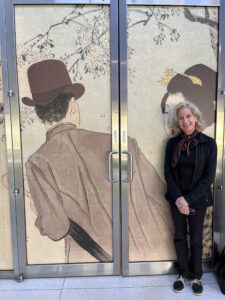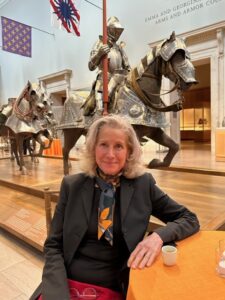JASA’s President on Collecting Japanese Art and Her Goals for the Society

Impressions recently met with Victoria Melendez, elected the society’s president in 2024, in the galleries of the Department of Arms and Armor at the Metropolitan Museum of Art, where we had just viewed an onsite presentation of Japanese swordsmanship (below). While she is well-known to many JASA members and fellow collectors, we invited Victoria to share some of her background and views on collecting Japanese art.
We are delighted to speak with you about your new leadership role with JASA. Members look forward to getting to know you better and to working with you. To begin our short conversation, please tell us about your early years. Where were you born? Where did you grow up, go to school?
I was born and raised in New York City. I attended the Fiorello H. LaGuardia High School of Music & Art and Performing Arts, where I focused on painting and drawing.
Were your parents both interested Japan, or in art? What interested you as a child?
My parents were both interested in art, such as painting and ancient art, and when I was a child often took me to museums, such as the Metropolitan Museum of Art. Rather than Japan, they were more interested in Spain and Latin America, probably because my father was from Colombia and my mother was a Spanish teacher.
Where did you do your undergraduate work? Your advanced degree?
I received my undergraduate degree from Harvard College, where I concentrated in East Asian Languages and Civilizations. I then went on to Harvard Law School, where I received a JD, and, after working as an attorney for four years, enrolled in Harvard Business School for an MBA.
What was your first job?
My very first job was during my junior year of high school as an intern in the Catalogue Department of the Metropolitan Museum. That department kept complete files on all of the objects in the Met’s collection and was used by curators, scholars and students for provenance and other research. The head of the department was Marica Vilcek, who was a wonderful boss and became a good friend. (A founder of the Vilcek Foundation, together with her husband, Jan, she is now an honorary trustee of the Metropolitan Museum.) That was a formative experience and stimulated my interest in museums and ultimately in collecting.
How did your career evolve?
While studying law at Harvard, I developed an interest in Japanese economics, business and law. In the mid-1980s, the first law firm for which I worked sent me to serve as a stagiaire, or trainee, at an affiliated law firm in Tokyo for almost two years. When I returned to the United States, I decided I was interested in learning more about the business aspects of transactions, which is why I returned to Harvard to obtain an MBA. After graduating from business school, I worked in the financial services industry, mainly in research. I worked in London for four years and Tokyo for six. I transferred back to New York in 1998 to join the portfolio management and client advisory groups of the Rockefeller family office until retiring from full-time employment at the end of 2021. I remain active part-time as an investment consultant.
When did you discover you were interested in art?
I started painting and drawing at the age of twelve. My mother especially encouraged my interest in art. As I mentioned, both my parents regularly took me to museums.
Are you drawn to other arts, such as theater, music and dance?
Yes, I like theater (particularly off-Broadway), opera and modern dance.
When and why did you decide to make Japan/Japanese art a lifetime pursuit? Have you studied Japanese?
My fascination with Japan and Japanese art began purely by chance. In the spring semester of my freshman year at Harvard, I was searching for an art history course and I happened to wander into a class on medieval Japanese art taught by John Rosenfield. I was mesmerized by the subject and by Professor Rosenfield’s wonderful lectures. That course changed the direction of my life! The teaching fellow at that time was Elizabeth ten Grotenhuis, who later became a professor of Japanese art at Boston University, and she encouraged me to study Japanese. I wound up having the equivalent of six years of formal language training: three at Harvard, two at Middlebury’s intensive summer language program and one at the Inter-University Center for Japanese Language Studies in Tokyo, aka the Stanford Center.
Do you collect Japanese art?
Yes, I have been collecting contemporary art, mainly ceramics and works on paper, beginning in 1991, when I acquired two screens from the Tolman Collection Tokyo.
Which artists/craftsmen do you admire and why?
I admire many artists but more so those whose work reflects mastery of their craft, such as the demanding medium of mezzotint, and those incorporating stylistic aspects unique to Japan.
Are you optimistic about the future of the Japanese art field here in the West?
Yes, in general I am. In terms of education, while the number of students studying art history (and the humanities overall) has declined over the past number of years and many schools have consequently cut back on their course offerings, there are at least 10 to 15 universities with strong Japanese art history departments and programs. There are about the same number of museums with active curators in the field of Japanese art.
Are there younger collectors and scholars coming along?
Yes, I believe so. Over the past 20 to 30 years, it seems that the scope of collectors’ interests has broadened to include not only traditional Japanese art but also modern and contemporary. In a similar vein, scholars are exploring those areas and producing many valuable publications.
Do you live with works of art in your own home?
Yes. I live with ceramics and contemporary works on paper that I have collected over some thirty years.
What is your most recent purchase?
My most recent purchase is a mezzotint by Hamanishi Katsunori (born in 1949), a brilliant artist who produces detailed compositions using a very difficult method.
Any hobbies or interests outside of the art world?
In addition to art, I am interested in travel, swimming and literature.

What advice would you give to a young person who wants to learn about collecting or to be a collector of Japanese art in the West now?
I would recommend joining JASA, visiting as many Japanese art exhibitions as possible and reading extensively on the subject, such as articles appearing in Impressions. A JASA membership will provide a subscription to the award-winning publication Impressions and the opportunity to visit private collections and to participate in behind-the-scenes and curator-led visits to museums, where one can meet like-minded collectors, scholars and students, as at our recent event in Chicago (above).
JASA also offers monthly Zoom webinars that have greatly enhanced its outreach. The topics and speakers are varied and they reach a large national and international audience. Every Zoom webinar is recorded and available on the JASA website.
You no doubt have big plans for the Japanese Art Society of America. Anything you can share at this early stage?
One important and basic goal is to increase awareness of JASA and its activities. Many people who are interested in Japanese art are simply unaware of the organization’s existence and what they are missing as a result. I would like to increase membership, expand our program offerings, including through social media, extend our membership and secure JASA’s future for the next 50 years by securing the funding of its capital campaign. As the new president of JASA, I very much look forward to hearing from members on their ideas for the society and I welcome their feedback on what we are proposing.
